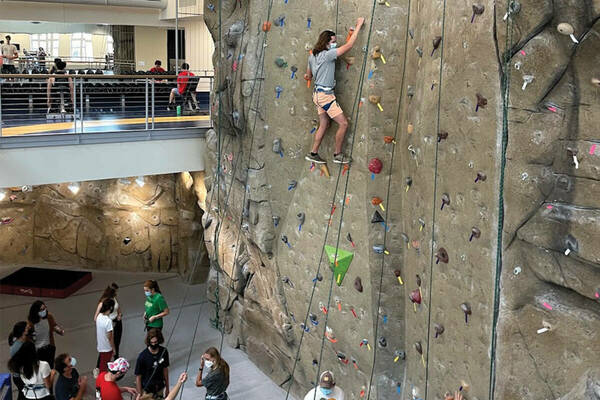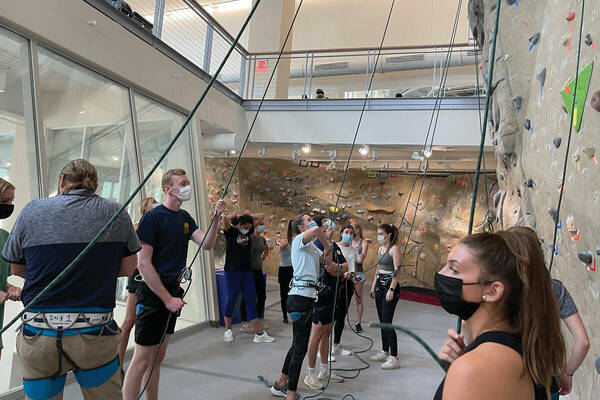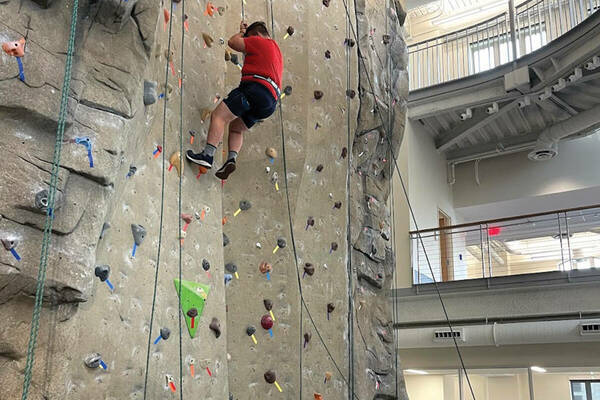
Colleen King, a senior science major in preprofessional studies and sociology, was initially skeptical about how becoming a compassionate health care provider had anything in common with climbing a vertical wall.

“Truth be told, I had never rock climbed before, so I was very curious how this activity would intertwine with the course,” King said about the class exercise held at the Notre Dame RecSports Climbing and Bouldering Wall. “I understood the aspect of attention-modeling that belaying offered, as med school students and residents are often required to do, but aside from that, I wasn’t exactly sure of the other parallels that existed.”
Belaying is a process of managing a rope that keeps climbers as safe as possible by limiting the distance of a fall. Belayers must maintain continual focus and not take their hands off their ropes, much the same way doctors have to focus on meeting their patients' needs and helping the patient get well.
For that reason, learning how to belay and climb has been integrated into the Compassionate Care in Medicine (CCIM) course in the College of Science since 2015. Dominic Vachon, the John G. Sheedy, M.D., Director of the Ruth M. Hillebrand Center for Compassionate Care in Medicine, had been on a climbing retreat in the Rocky Mountains when he recognized the analogy.
“Belay training is a powerful way for students going into helping professions to experience another person completely relying on them for their safety,” Vachon said.
Many parallels exist.
Dr. Katharine Callaghan ’12, a family medicine faculty physician for Memorial Hospital Family Medicine Residency Program and an adjunct professor in the Hillebrand Center, described many of the similarities, which were confirmed by Tony Blasucci, the climbing and bouldering wall program coordinator who helped with the belaying portion of the class. Some of their top ones:
- Belaying requires constant concentration, and so does medicine. “As the belayer, you are focusing exclusively on the person who is climbing, and similarly in the doctor-patient relationship, it requires incredible attention to be attuned to what this person needs,” Callaghan said. “Do they need more space? Do they need less space?”
- Climbers have to trust that belayers will keep them safe. Both are required to properly wear specialized harnesses that are attached to a dynamic climbing rope using a locking carabiner, with locked carabiners around their waists. The climbers traverse above the room’s horizon. It’s a vulnerable thing to do, not unlike the trust patients place in doctors.
- Medical errors can happen when equipment isn’t checked and arranged properly before a procedure. If belayers don’t check their equipment, a climber can fall.
Because 66 students is too many to teach belaying to all at once, they were divided into three groups and used the climbing wall during separate sessions throughout the semester. At almost 38 feet tall, the height of the Duncan Student Center climbing wall (called the top roping wall because the ropes are pre-fastened at the top of the structure) allows the Notre Dame community to safely challenge themselves or train to climb outdoors.
“In the context of the class we have a third person, a backup belayer, who will also participate in the safety check, and have that third set of eyes,” Blasucci said.

To communicate with each other, belayers and climbers use a series of cues to make sure both are prepared for the climb.
"We say, ‘On belay?’ ‘Belay on.’ ‘Climbing?’ ‘Climb on,’” said Robbie Duncheskie, a junior majoring in neuroscience and behavior and minoring in science, technology and values. “This communication between the pair ensures that they trust each other. In the medical world, this is necessary in order to reach the main goal: successful treatment. As for the climbers, they have their own goal: the top of the wall.”
Callaghan appreciated other parallels between practicing medicine and belaying as well. Though she didn’t observe much frustration or fear, theoretically there will be students afraid of heights who don’t want to do the exercise. Or, they may be interested and complete the exercise, but they also don’t want to give up the comfort of the ground. The required communication meant that students had to get to know each other better to figure out what motivates and encourages each person.
It’s similar to working with a patient to make a change, Callaghan said.
“I have numerous conversations with patients about quitting smoking; in some ways they want to quit, but in other ways they don’t,” Callaghan said. “They get some benefit out of not quitting, but it’s really bad for their health. So I need to understand what those perceived benefits are to be able to reach them.”
“In belaying, I would have to emphasize my communication with the climber. Is there something I can do to help? I can say, ‘Put your foot here; the next step is there,’ but some people hate that and say it makes them more nervous,” she added.
Compassionate care in medicine doesn’t only happen in one direction, however. Medical providers also need to show compassion to themselves, and be ready and able to help each patient at their highest level. The belayer has to be of sound body and mind to attend to the climber’s needs.
“Similarly if I am burned out as a physician and not attending to my own physical, emotional, and spiritual well being, I’m also not going to be able to be present for the patient in the same way,” Callaghan said.
Vachon believes so strongly in the belay exercise that it wasn’t completely written out of the course in 2020, when Covid protocols prevented students from gathering at the climbing wall. He and now medical student, Marissa Vander Missen ’21, created a humorous but effective demonstration recorded through Zoom using a stuffed panda bear for the Fall 2020 class.
“In the science of compassion training, we do not separate a clinician’s competence from their compassionate focus on the patient—compassion and competence are the two sides of the same coin,” Vachon said.
Students in the class shared a variety of reasons they enjoyed the exercise of belaying. King, who at first didn’t know how belaying had much in common with the practice of medicine, enjoyed the opportunity to debrief with other students after each session.
“My classmates had very thoughtful insights ranging from the importance of always checking one's tools before use, to the vast amount of knowledge that can be acquired simply from observing someone do an activity,” she said.
Duncheskie appreciated that even though most of the students didn’t know each other well before the class, they learned to trust each other with their safety. The component of trust—and being trusted—can not be learned from a book.
“In teaching compassion in medicine, it is not enough to just read about it,” Vachon said. “That is why we develop these kinds of teaching methods in order to help students really feel how compassion is the foundation of everything we do in medicine.”
Originally published by at science.nd.edu on January 26, 2022.

